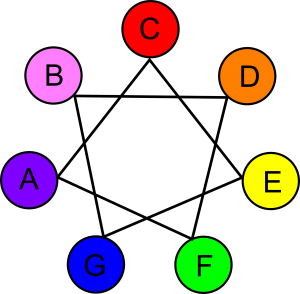 Coloring notes to indicate different pitches is not a new concept. The problem is, there is no standard accepted color associated with each pitch. Probably the most common color scheme today would be the “Chroma-Notes” colors used by Boomwhackers. This system makes allowances for blended colors on the flats/sharps. The thinking behind these colors is discussed on this page.
Coloring notes to indicate different pitches is not a new concept. The problem is, there is no standard accepted color associated with each pitch. Probably the most common color scheme today would be the “Chroma-Notes” colors used by Boomwhackers. This system makes allowances for blended colors on the flats/sharps. The thinking behind these colors is discussed on this page.
Candida Tobin used her own system of colors for teaching beginning music students with great success. The colors seem to have been chosen arbitrarily.
The “We Hear and Play” system for teaching absolute pitch was used by the Tanedas when training very young children to play piano. Again, the colors chosen seem to be in random order.
| Boomwhackers | Tobin | Taneda | |
|---|---|---|---|
| C | Red | Yellow | Red |
| D | Orange | Purple | Yellow |
| E | Yellow | Orange | Green |
| F | Lime Green | Brown | Orange |
| G | Teal | Red | Blue |
| A | Indigo | Blue | Gray |
| B | Magenta | Green | Brown |
Here’s the color scheme that makes the most sense to me at this point, especially when using these colors with small children (try using “indigo” or “magenta” with kids, for example). The Mr. Noteman system would be a slight modification of the rainbow colors (ROYGBIV), close to the Boomwhacker designations.
Proposed Mr. Noteman Coloring System
C – Red
D – Orange
E – Yellow
F – Green
G – Blue
A – Purple
B – Pink
I do not know how extensively I would use colored notes for teaching pitches. I am very leery of getting too far away from teaching what music looks like when encountered in the “real” world. I do know that for small children, colors are very much less abstract than trying to decipher a notehead’s location on a staff.



Leave a Reply